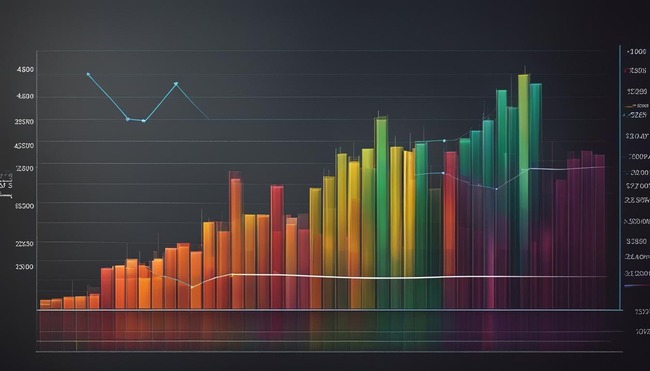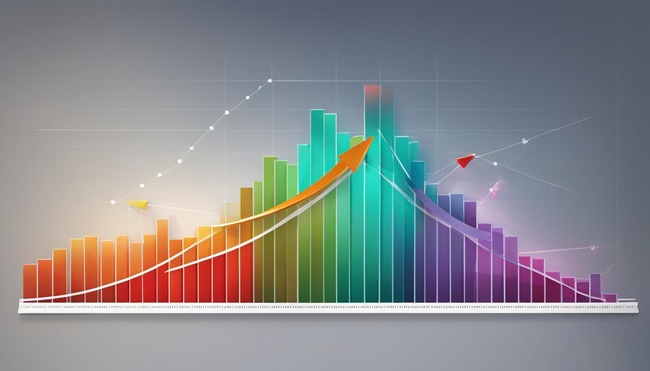Every business must have sales projections to stay on top of its financial goals. Accurate sales forecasting provides businesses with data-driven insights that are useful in making strategic business decisions. In this section, we will explore the importance of sales forecasting and how it can enhance profits and productivity.

Accurate sales forecasting is important and a powerful tool for businesses to predict estimated future sales and enhance their strategic planning. It helps businesses make informed decisions about their marketing, inventory, and staffing requirements. Accurate forecasting also allows businesses to identify potential problems early in the sales process, enabling them to adjust their strategies.
Data-driven forecasting provides businesses with the ability to analyze sales trends, identify areas of opportunity, and make informed decisions. By leveraging historical data, businesses can create accurate forecasts that help them meet their financial goals. Accurate forecasting can also help businesses save time and resources by allowing them to focus on high-value opportunities.
Enhancing profits and productivity is the ultimate goal of accurate sales forecasting. It helps businesses identify the key drivers of sales and develop effective strategies for leveraging those drivers. Effective forecasting can also help businesses optimize their resources and streamline their operations. By enhancing profits and productivity, businesses can achieve sustainable growth and success.
Key Takeaways
- Sales forecasting is an essential tool for businesses to predict future sales and enhance their strategic planning.
- Data-driven forecasting provides businesses with the ability to analyze sales trends, identify areas of opportunity, and make informed decisions.
- Accurate forecasting helps businesses optimize their resources, streamline their operations, and achieve sustainable growth and success.
- Accurate sales forecasting can help businesses save time and resources by allowing them to focus on high-value opportunities.
- Effective forecasting helps businesses identify the key drivers of sales and develop effective strategies for leveraging those drivers.
The Benefits of Sales Forecasting for Business Owners and Sales Professionals
Implementing accurate sales forecasting strategies can provide numerous benefits for both business owners and sales professionals. By utilizing forecasting methods and historical sales data, businesses can make informed decisions that can improve sales revenue and enhance the overall sales process.
Forecasting Methods
Creating an accurate sales forecast involves analyzing historical sales data to identify patterns and trends. By delving into past performance, businesses can gain valuable insights into the ebb and flow of sales, enabling them to make informed projections for the future. However, relying solely on historical sales forecasting may not be sufficient in today’s rapidly evolving markets.
To enhance the precision of sales forecasts, businesses can explore different sales forecasting tools and methodologies. These tools take into account various factors, such as market trends, customer behavior, and industry fluctuations, providing a more comprehensive view of the sales landscape.
Accurate sales forecasts allow businesses to optimize their strategies, allocate resources efficiently, and adapt to changing market dynamics. Whether it’s adjusting marketing campaigns or fine-tuning inventory management, the ability to make accurate sales forecasts empowers businesses to stay agile and competitive.
Historical Sales Data
Using past sales data is crucial in accurately predicting future sales revenue. By analyzing trends and patterns in historical sales data, businesses can identify potential opportunities and challenges. This information can then be used to create more accurate sales forecasts, set achievable sales goals and impact your sales.
| Benefits | Drawbacks | |
|---|---|---|
| Quantitative Forecasting | -Uses data-driven methods -Provides accurate predictions | -Doesn’t account for external factors -Cannot predict sudden changes |
| Qualitative Forecasting | -Considers expert opinions -Can account for external factors | -May be subjective -Less reliable than quantitative methods |
Sales Revenue and Sales Goals
Using accurate sales forecasting can help businesses set achievable sales goals. By analyzing historical sales data and utilizing forecasting methods, businesses can create realistic sales revenue targets. This information can also help sales professionals prioritize their efforts and focus on the areas that can drive the most revenue.
Sales Process
Effective sales forecasting can align with the sales process and help sales professionals determine the best approach to achieve their goals. By understanding the sales cycle and forecasting potential revenue, sales professionals can make informed decisions on how to approach each potential client. This can help shorten the sales cycle, improve customer relationships, and increase overall productivity.
Accurate sales forecasting can help businesses and sales professionals achieve their sales goals and enhance their overall sales process. By utilizing forecasting methods and historical sales data, businesses can make strategic decisions that can ultimately drive revenue growth and improve productivity.

Practical Tips for Effective Sales Forecasting in the Philippines
Accurate sales forecasting is crucial for businesses in the Philippines. By having a clear understanding of future sales, you can make informed decisions and plan for growth. In this section, we’ll provide practical tips to help you build an effective sales forecast for your business.
The Sales Pipeline
The sales pipeline is a crucial tool for sales forecasting. It’s a visual representation of your sales process, from lead generation to closing deals. By analyzing your pipeline, you can determine the health of your sales process and identify bottlenecks that need to be addressed.
Here’s an example of what a sales pipeline might look like:
| Stage | Number of Opportunities | Estimated Revenue |
|---|---|---|
| Prospecting | 20 | $20,000 |
| Qualification | 15 | $15,000 |
| Needs Analysis | 10 | $10,000 |
| Proposal | 7 | $7,000 |
| Negotiation | 4 | $4,000 |
| Closed/Won | 3 | $3,000 |
By tracking the number of opportunities and estimated revenue for each stage of the pipeline, you can create a data-driven sales forecast.
Sales Leaders and Managers
Effective sales forecasting requires buy-in from sales leaders and managers. They play a critical role in ensuring that the sales pipeline is up-to-date and accurate. By having regular check-ins and coaching sessions, sales leaders and managers can help sales reps move deals through the pipeline and close more deals.
Sales Forecasting Tools
Various sales forecasting tools exist, ranging from basic spreadsheets to sophisticated CRM systems. The crucial factor is identifying a tool that aligns with your business requirements and furnishes the necessary data for well-informed decision-making. Here are a few widely-used sales forecasting tools:
- Microsoft Excel: An uncomplicated yet robust tool for crafting sales forecasts.
- Tarkie: A leading CRM tool renowned for its integrated sales forecasting module.
- HubSpot: A comprehensive CRM solution encompassing advanced sales forecasting capabilities.
When choosing a sales forecasting tool, take into account factors such as the scale of your business, financial considerations, and your unique requirements. Notably, Tarkie stands out as a top-notch CRM with exceptional sales forecasting features.
Building a Sales Forecast
Building a sales forecast involves analyzing past sales data, reviewing your sales pipeline, and taking into account external factors that may impact sales. Here are the steps to building a sales forecast:
- Review historical sales data for the past 12-24 months.
- Analyze trends and identify patterns in the data.
- Review your sales pipeline to determine the number of opportunities and estimated revenue for each stage.
- Consider external factors, such as industry trends and economic forecasts.
- Use a sales forecasting tool, such as Excel or a CRM system, to create a data-driven sales forecast.
By following these practical tips, you can create an effective sales forecast that helps you make informed decisions and plan for growth.
Enhancing Sales Performance with Accurate Sales Forecasting
In the realm of business, accurate sales predictions are a cornerstone for success. Sales managers simply ask: What sales numbers do we want to forecast for the next quarter or year? The answer lies in understanding different sales cycles, a crucial aspect for any forecasting method.
Individual sales, spanning across various products or services, contribute to the overall expected sales revenue. Whether you’re dealing with short, transactional cycles or longer, relationship-based cycles, each has a unique impact on the entire sales landscape. To meet your sales goals, it’s essential to recognize how these different sales cycles interplay.
One common forecasting method relies on historical data—analyzing past sales performance to project future trends. By examining two sales, current and past, businesses can paint an accurate picture of expected sales. However, it’s vital to note that a forecast is based on the assumption that historical trends will continue.
To navigate the intricacies of forecasting, sales managers must go beyond mere numbers. They need to understand the nuances of individual sales and the broader scope of different sales cycles. Only by doing so can businesses make accurate predictions, ensuring they are well-equipped to adapt and thrive in the ever-changing landscape of commerce.
Setting Sales Targets Based on Past Sales Data
One effective way to utilize past sales data is to set sales targets based on historical sales performance. By analyzing previous sales trends, businesses can set realistic targets for the future. For example, if a business has consistently hit 10% growth each quarter, they can set their sales target to achieve at least 10% growth in the upcoming quarter.
| Quarter | Sales Revenue | Quarterly Growth |
|---|---|---|
| Q1 2020 | $100,000 | N/A |
| Q2 2020 | $110,000 | 10% |
| Q3 2020 | $121,000 | 10% |
| Q4 2020 | $133,100 | 10% |
Table: Example of past sales data and quarterly growth
Utilizing Opportunity Stage Forecasting
Another effective way to enhance sales performance is to utilize opportunity stage forecasting. This involves tracking potential sales opportunities and analyzing the likelihood of closing them. By tracking the progress of these opportunities through the sales process, businesses can get a better understanding of which opportunities are likely to close and which ones may fall through.
For example, a business may have a sales pipeline with five stages:
- Initial Contact
- Needs Assessment
- Proposal
- Negotiation
- Closed Won/Closed Lost
By tracking potential sales opportunities through each of these stages, businesses can gain valuable insights on their sales process and identify areas for improvement. They can also use this information to adjust their sales targets and quotas based on the probability of closing different deals.
Setting Sales Quotas
Setting sales quotas is another effective way to enhance sales performance. By setting quotas for each sales representative or team, businesses can drive sales performance and ensure they are on track to meet their overall sales targets.
When setting sales quotas, it’s important to take into account historical sales data, opportunity stage forecasting, and overall business goals. By doing so, businesses can set realistic quotas that push sales representatives to perform at their best while also ensuring they are achievable.

By leveraging accurate sales forecasting strategies such as setting sales targets based on past sales data, utilizing opportunity stage forecasting, and setting sales quotas, businesses can enhance their sales performance and drive business growth. By consistently tracking and analyzing their sales data, they can adjust their strategies as needed to ensure they are on track to meet their goals and increase sales.
Conclusion
Accurate sales forecasting is a crucial component of any successful business strategy. By utilizing sales forecast estimates and predictions, businesses can stay on track towards meeting their sales goals and driving growth. However, it is important to remember that actual sales may deviate from forecasts, and effective sales management is necessary to adapt and pivot accordingly.
By implementing the practical tips discussed in this article, businesses can enhance their sales forecasting capabilities and improve sales performance. From building a comprehensive sales forecast to utilizing opportunity stage forecasting and setting sales quotas, businesses can use data-driven methods to increase sales and productivity.
Remember, sales forecasting is not a one-time event but an ongoing process that requires consistent attention and adjustment. With a well-managed sales pipeline and strong sales leadership, businesses in the Philippines can leverage accurate sales forecasting to drive success and meet their sales goals.
